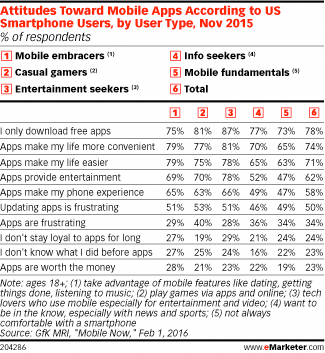Who Gets the Most out of Mobile?
February 5, 2016
![]() The mobile audience is not homogeneous, according to November 2015 research. And the way different groups rely on their mobile devices translates to different attitudes toward ads—and apps.
The mobile audience is not homogeneous, according to November 2015 research. And the way different groups rely on their mobile devices translates to different attitudes toward ads—and apps.
 Using regression analysis, GfK identified five distinct groups of mobile consumers—groupings that were based more on behaviors than psychographics or life stages. Mobile fundamentals and mobile embracers each represent about a quarter of the mobile population, and make up the largest groups. The embracers live their lives on mobile—but the fundamentals are not always comfortable with a smartphone.
Using regression analysis, GfK identified five distinct groups of mobile consumers—groupings that were based more on behaviors than psychographics or life stages. Mobile fundamentals and mobile embracers each represent about a quarter of the mobile population, and make up the largest groups. The embracers live their lives on mobile—but the fundamentals are not always comfortable with a smartphone.
Casual gamers and info seekers each represented 18% of the pie. The former play games via apps and online, and skew toward white married women with kids, while the latter group skews toward white, educated, married men, who want to keep up with news and sports.
Entertainment seekers were the smallest group, at 15%, and focus around younger people who are often single and students.
 These groups often have very different attitudes toward apps, according to GfK’s findings. While most respondents overall said apps made their lives easier, for example, mobile embracers, casual gamers and entertainment seekers overindexed on this measure. The same three groups were also notably more likely to say apps provided entertainment and made their phone an “experience.”
These groups often have very different attitudes toward apps, according to GfK’s findings. While most respondents overall said apps made their lives easier, for example, mobile embracers, casual gamers and entertainment seekers overindexed on this measure. The same three groups were also notably more likely to say apps provided entertainment and made their phone an “experience.”
The same groups also overindexed on some negative app sentiments: Entertainment seekers were the least likely group to say they were loyal to apps, for example.
The different mobile audiences also had different opinions about mobile ads. Mobile embracers and entertainment seekers overindexed in their willingness to receive more ads in exchange for perks like lower monthly mobile fees or free text messaging.
Entertainment seekers were also the most likely group to say that mobile ads had no credibility—even though at the same time they overindexed in saying ads provided them with useful information about products, services and bargains.
Nearly three-quarters of all respondents thought mobile ads were annoying, with info seekers the most likely to say they were irked by ads. The same group was also the least likely to see benefits to ads.
eMarketer estimates that this year, US advertisers will spend $42.01 billion reaching consumers with mobile placements, including all ad formats service to all mobile internet-connected devices.
Courtesy of eMarketer































